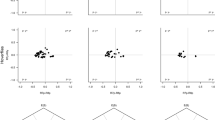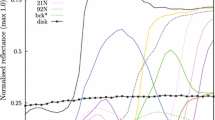Abstract
Flower colours are important cues shaping the interaction between plants and pollinators. Plants flowering in distinct habitats like grasslands and forests present their flowers in very different light environments and against different backgrounds. Since most Angiosperms depend on or profit from pollination by animals, plants may exhibit flower colours that are most conspicuous when seen in the predominant illumination or against the predominant background colour of their environment. To compare flower colours of different habitats, we collected flower reflectance spectra of 239 herbs from forest and grassland sites in three German regions. We compared chromatic and achromatic components of flower colours from the honeybee’s point of view as well as in principal component analysis (PCA) to exclude the bias of particular visual systems. Our results show that flower colours do not differ between closed forest and open grassland habitats in any chromatic or achromatic aspect both from the bee’s perspective and without any model bias (PCA). Thus, although the colours of lights and backgrounds are different between both types of habitats, we find no evidence of an adaptation of flower colours to the visual system of bees. The finding that flower colours look similar for bees in different environments may be related to a mechanism called colour constancy which allows bees and other pollinator species to compensate for varying illumination conditions.







Similar content being viewed by others
References
Arnold SEJ, Chittka L (2012) Illumination preference, illumination constancy and colour discrimination by bumblebees in an environment with patchy light. J Exp Biol 215:2173–2180. doi:10.1242/jeb.065565
Avarguès-Weber A, Mota T, Giurfa M (2012) New vistas on honey bee vision. Apidologie 43:244–268. doi:10.1007/s13592-012-0124-2
Backhaus W (1991) Color opponent coding in the visual system of the honeybee. Vision Res 31:1381–1397
Baker HG, Hurd PD (1968) Interfloral ecology. Annu Rev Entomol 13:385–414
Beattie AJ (1969) Studies in the pollination ecology of Viola. 1. The pollen-content of stigmatic cavities. Watsonia 7:142–156
Benard J, Giurfa M (2008) The cognitive implications of asymmetric colour generalization in honeybees. Anim Cogn 11:283–293. doi:10.1007/s10071-007-0112-5
Ben-Tal Y, King RW (1997) Environmental factors involved in colouration of flowers of Kangaroo Paw. Sci Hortic 72:35–48. doi:10.1016/S0304-4238(97)00071-X
Binkenstein J, Renoult JP, Schaefer HM (2013) Increasing land-use intensity decreases floral colour diversity of plant communities in temperate grasslands. Oecologia 173:461–471. doi:10.1007/s00442-013-2627-6
Chittka L (1992) The colour hexagon: a chromaticity diagram based on photoreceptor excitations as a generalized representation of colour opponency. J Comp Physiol A 170:533–543
Chittka L (1999) Bees, white flowers, and the colour hexagon—a reassessment? No, not yet. Naturwissenschaften 86:595–597
Chittka L, Beier W, Hertel H (1992) Opponent colour coding is a universal strategy to evaluate the photoreceptor inputs in Hymenoptera. J Comp Physiol A 170:545–563
Chittka L, Shmida A, Troje N, Menzel R (1994) Ultraviolet as a component of flower reflections, and the colour perception of Hymenoptera. Vis Res 34:1489–1508
Chittka L, Thomson JD, Waser NM (1999) Flower constancy, insect psychology, and plant evolution. Naturwissenschaften 86:361–377
Chittka L, Spaethe J, Schmidt A, Hickelsberger A (2001) Adaptation, constraint, and chance in the evolution of flower colour and pollinator colour vision. In: Chittka L, Thomson JD (eds) Cogn. Ecol. Pollinat. Cambridge University Press, Cambridge, pp 106–126
Chittka L, Faruq S, Skorupski P, Werner A (2014) Colour constancy in insects. J Comp Physiol A 200:435–448. doi:10.1007/s00359-014-0897-z
Christ K-D (2004) Die Blütenökologie der Krautschicht naturnaher Wälder in der Umgebung von Ulm, Süddeutschland. Dissertation
Cuthill IC, Bennett ATD, Partridge JC, Maier EJ (1999) Plumage reflectance and the objective assessment of avian sexual dichromatism. Am Nat 153:183–200
Development Core Team R (2013) R: a language and environment for statistical computing. R Foundation for Statistical Computing, Vienna
Dyer AG (2006) Discrimination of flower colours in natural settings by the bumblebee species Bombus terrestris (Hymenoptera: Apidae). Entomol Gen 28:257–268
Dyer AG, Chittka L (2004) Biological significance of distinguishing between similar colours in spectrally variable illumination: bumblebees (Bombus terrestris) as a case study. J Comp Physiol 190:105–114. doi:10.1007/s00359-003-0475-2
Dyer AG, Boyd-Gerny S, McLoughlin S et al (2012) Parallel evolution of angiosperm colour signals: common evolutionary pressures linked to hymenopteran vision. Proc R Soc B Biol Sci 279:3606–3615. doi:10.1098/rspb.2012.0827
Endler JA (1993) The colour of light in forests and its implications. Ecol Monogr 63:1–27
Faegri K, van der Pijl L (1979) The principles of pollination ecology, 3rd edn. Pergamon Press, Oxford
Faruq S, McOwan PW, Chittka L (2013) The biological significance of colour constancy: an agent-based model with bees foraging from flowers under varied illumination. J Vis 13:10. doi:10.1167/13.10.10
Fischer M, Bossdorf O, Gockel S et al (2010) Implementing large-scale and long-term functional biodiversity research: the biodiversity exploratories. Basic Appl Ecol 11:473–485. doi:10.1016/j.baae.2010.07.009
Frey FM (2004) Opposing natural selection from herbivores and pathogenes may maintain floral-colour variation in Claytonia virginica (Portulacaceae). Evolution 58:2426–2437. doi:10.1111/j.0014-3820.2004.tb00872.x
Giurfa M, Vorobyev M (1998) The angular range of achromatic target detection by honeybees. J Comp Physiol A 183:101–110
Giurfa M, Vorobyev M, Kevan P, Menzel R (1996) Detection of coloured stimuli by honeybees: minimum visual angles and receptor specific contrasts. J Comp Physiol A 178:699–709
Gumbert A (2000) Color choices by bumble bees (Bombus terrestris): innate preferences and generalization after learning. Behav Ecol Sociobiol 48:36–43. doi:10.1007/s002650000213
Hempel de Ibarra N, Vorobyev M, Brandt R, Giurfa M (2000) Detection of bright and dim colours by honeybees. J Exp Biol 203:3289–3298
Hempel de Ibarra N, Giurfa M, Vorobyev M (2002) Discrimination of coloured patterns by honeybees through chromatic and achromatic cues. J Comp Physiol A 188:503–512. doi:10.1007/s00359-002-0322-x
Hensel LE, Sargent RD (2012) A phylogenetic analysis of trait convergence in the spring flora. Botany 90:557–564. doi:10.1139/b2012-029
Irwin RE, Strauss SY, Storz S et al (2003) The role of herbivores in the maintenance of a flower colour polymorphism in wild radish. Ecology 84:1733–1743
Johnson ET, Berhow MA, Dowd PF (2008) Colored and white sectors from star-patterned Petunia flowers display differential resistance to corn earworm and cabbage looper larvae. J Chem Ecol 34:757–765. doi:10.1007/s10886-008-9444-0
Klooster MR, Clark DL, Culley TM (2009) Cryptic bracts facilitate herbivore avoidance in the mycoheterotrophic plant Monotropsis odorata (Ericaceae). Am J Bot 96:2197–2205. doi:10.3732/ajb.0900124
Lehrer M, Bischof S (1995) Detection of model flowers by honeybees: the role of chromatic and achromatic contrast. Naturwissenschaften 82:145–147
Lunau K, Wacht S, Chittka L (1996) Colour choices of naive bumble bees and their implications for colour perception. J Comp Physiol A 178:477–489
Lynn SK, Cnaani J, Papaj DR (2005) Peak shift discrimination learning as a mechanism of signal evolution. Evolution 59:1300–1305. doi:10.1111/j.0014-3820.2005.tb01780.x
Martínez-Harms J, Márquez N, Menzel R, Vorobyev M (2014) Visual generalization in honeybees: evidence of peak shift in color discrimination. J Comp Physiol A Neuroethol Sens Neural Behav Physiol 200:317–325. doi:10.1007/s00359-014-0887-1
Menzel R, Shmida A (1993) The ecology of flower colours and the natural colour vision of insect pollinators: the Israeli flora as a study case. Biol Rev 68:81–120
Mori M, Yoshida K, Ishigaki Y et al (2005) UV-B protective effect of a polyacylated anthocyanin, HBA, in flower petals of the blue morning glory, Ipomoea tricolor cv. Heavenly Blue. Bioorg Med Chem 13:2015–2020. doi:10.1016/j.bmc.2005.01.011
Motten AF (1986) Pollination ecology of the spring wildflower community of a temperate deciduous forest. Ecol Monogr 56:21–42
Neumeyer C (1981) Chromatic adaptation in the honeybee: successive color contrast and color constancy. J Comp Physiol 144:543–553
Neumeyer C (1998) Comparative aspects of colour constancy. In: Walsh V, Kulikowski J (eds) Percept. Constancy why things look they do. Cambridge University Press, Cambridge, pp 323–351
Ollerton J, Winfree R, Tarrant S (2011) How many flowering plants are pollinated by animals? Oikos 120:321–326. doi:10.1111/j.1600-0706.2010.18644.x
Osorio D, Vorobyev M (2008) A review of the evolution of animal colour vision and visual communication signals. Vis Res 48:2042–2051. doi:10.1016/j.visres.2008.06.018
Peitsch D, Fietz A, Hertel H et al (1992) The spectral input systems of hymenopteran insects and their receptor-based colour vision. J Comp Physiol A 170:23–40
Raine NE, Chittka L (2007) The adaptive significance of sensory bias in a foraging context: floral colour preferences in the bumblebee Bombus terrestris. PLoS One 2:e556. doi:10.1371/journal.pone.0000556
Schaefer HM, Ruxton GD (2011) Plant–animal communication. Oxford University Press, Oxford
Schemske DW, Bierzychudek P (2007) Spatial differentiation for flower colour in the desert annual Linanthus parryae: Was Wright right? Evolution 61:2528–2543. doi:10.1111/j.1558-5646.2007.00219.x
Schemske DW, Willson MF, Melampy MN et al (1978) Flowering ecology of some spring woodland herbs. Ecology 59:351–366
Schmidt M, Ewald J, Fischer A et al (2003) Liste der in Deutschland typischen Waldgefäßpflanzen. Mitteilungen Bundesforschungsanstalt Für Forst- Holzwirtsch 212:1–33
Shirreffs D (1985) Biological flora of the British Isles. Anemone nemorosa L. J Ecol 73:1005–1020
Showler AJ, Rich TCG (1993) Cardamine bulbifera (L.) Crantz (Cruciferae) in the British Isles. Watsonia 19:231–245
Spaethe J, Tautz J, Chittka L (2001) Visual constraints in foraging bumblebees: flower size and colour affect search time and flight behavior. PNAS 98:3898–3903
Stoddard MC, Prum RO (2008) Evolution of avian plumage colour in a tetrahedral colour space: a phylogenetic analysis of New World Buntings. Am Nat 171:755–776. doi:10.1086/587526
Valido A, Schaefer HM, Jordano P (2011) Colour, design and reward: phenotypic integration of fleshy fruit displays: phenotypic integration of fleshy fruits. J Evol Biol 24:751–760. doi:10.1111/j.1420-9101.2010.02206.x
Vamosi JC, Knight TM, Steets JA et al (2006) Pollination decays in biodiversity hotspots. Proc Natl Acad Sci 103:956–961. doi:10.1073/pnas.0507165103
Vorobyev M, Brandt R (1997) How do insect pollinators discriminate colors? Isr J Plant Sci 45:103–113. doi:10.1080/07929978.1997.10676677
Vorobyev M, Osorio D (1998) Receptor noise as a determinant of colour thresholds. Proc Biol Sci 265:351–358. doi:10.1098/rspb.1998.0302
Wyszecki G, Stiles WS (1982) Color science: concepts and methods, quantitative data and formulae, 2nd edn. Wiley, New York
Acknowledgments
We thank Kalliope Stournaras for valuable comments on the manuscript. We thank A. Bogenrieder and S. Boch for helping to identify plant species. We thank B. Kreuzinger-Janik, K. Kohlberg, J. Kramer, and D. Behringer for field assistance. We thank the managers of the three Exploratories, Swen Renner, Sonja Gockel, Kerstin Wiesner, and Martin Gorke, for their work in maintaining the plot and project infrastructure; Simone Pfeiffer and Christiane Fischer for giving support through the central office; Michael Owonibi for managing the central data base; and Markus Fischer, Eduard Linsenmair, Dominik Hessenmöller, Jens Nieschulze, Daniel Prati, Ingo Schöning, François Buscot, Ernst-Detlef Schulze, Wolfgang W. Weisser, and the late Elisabeth Kalko for their role in setting up the Biodiversity Exploratories project. The work has been funded by the German Research Foundation (DFG) Priority Program 1374 “Infrastructure-Biodiversity-Exploratories” (Scha1008/5-1) and by the FAZIT-Stiftung. Field work permits were issued by the responsible state environmental offices of Baden-Württemberg, Thüringen, and Brandenburg (according to § 72 BbgNatSchG). Data collection complies with the current laws of Germany.
Author information
Authors and Affiliations
Corresponding author
Additional information
Handling Editor: Lars Chittka.
Electronic supplementary material
Below is the link to the electronic supplementary material.
Rights and permissions
About this article
Cite this article
Binkenstein, J., Schaefer, H.M. Flower colours in temperate forest and grassland habitats: a comparative study. Arthropod-Plant Interactions 9, 289–299 (2015). https://doi.org/10.1007/s11829-015-9369-9
Received:
Accepted:
Published:
Issue Date:
DOI: https://doi.org/10.1007/s11829-015-9369-9




